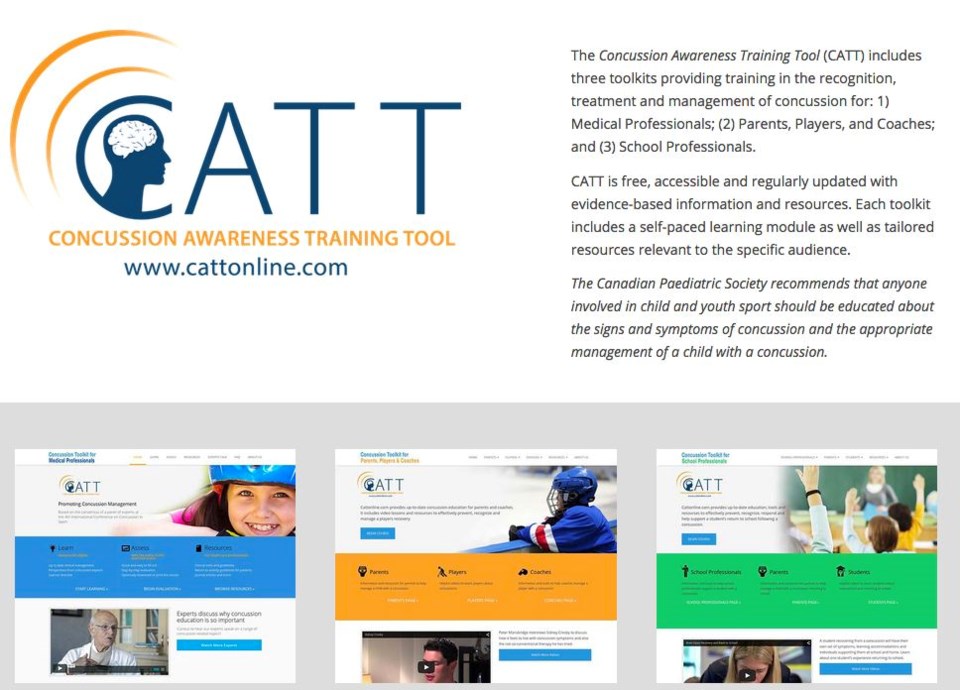A new child concussion resource is pooling symptom management and strategies into one place for parents, schools and coaches.
"Children and youth tend to take a longer time to recover simply because their brains are still developing, their head and neck musculature is still forming so it's really imperative that how a concussion is handled in the minutes, days, hours after injury can really affect the extent of damage and the recovery from injury," said Dr. Shelina Babul, a sports injury specialist.
She's also the associate director and at the BC Injury Research & Prevention Unit and BC Children's Hospital, which developed the Concussion Awareness Training Tool (CATT).
Online at www.cattonline.com, it will be updated on a monthly basis and is broken down into sections for the key adults involved in the affected student's life. For the teachers, CATT has suggested modifications, such as reducing reading and homework, shortening the school day or adjusting deadlines for projects and tests.
The goal is to provide better care and better outcomes, because if properly managed, 85 per cent of concussions can be resolved after two weeks.
The conversation around concussion started picking up after Sidney Crosby was sidelined, Babul said, and it started to reveal gaps in approach among the average Canadian.
"We recognized very quickly that there was a disconnect in the standard of care that was being given at all levels," Babul said.
"From medical provisions themselves, to parents and coaches not being aware of how to recognize and manage their child or player, school professionals for students reintegrating into the school setting."
Announced this week, it's still early days for getting it in the hands of educators.
"For each of the tools we're contacting the necessary agencies, organizations, groups to help disseminate," she said, so they're just starting to send them to school districts, teachers associations and more. "It's important to really stress return to learn should definitely come before return to play."
After looking at the tool for the first time, Grant Erickson, a football coach and teacher at College Heights secondary school, said he sees a need for it.
"It looks awesome, just having a resource that everyone can go to. It sort of helps everyone get on the same page," said Erickson, who has taken a sports aide program in the past that covers concussion injuries.
Returning to the classroom is a key part in a youth's recovery, Erickson said, and should be highlighted.
"It's been a piece that's been missing," Erickson said, "To help the teachers in the school to be able to bring a kid a back into the school, re-enter into the school and have a plan in place so that the recovery speeds up.
"It think it's huge."
It's important to acknowledge a concussion is a brain injury, Babul said.
"If you think about it, really the mechanics around what's happening to the brain, it's a movement of the brain inside the skull and I don't think a lot of people recognize that it is a brain injury," she said.
"It's not just a knock to the skull."
After a head injury, simple things at school can bring back symptoms, the release noted.
"Stimulation from other kids in the classroom, loud noises on the playground, and the stress of school work can trigger headaches, nausea, dizziness and confusion."
"It's such a difficult thing to diagnose," said Erickson, and as a coach that's not their role, but it helps for all involved to understand the symptoms.
"It's making the teachers aware and giving the teachers some tools to deal with it so when they do come back to school it's not overwhelming.
"There's pieces in place where we can lighten the workload. Or bringing them to school for half a day at a time. It's advantageous to the school."
For Erickson, it's also important to stress more talk between parents, coaches and other teachers who aren't aware of the child's outside activities.
"It would be so much more helpful to the teachers in the school if they knew ahead of time (that a player was hurt)," he said.
"The communication is huge, letting the staff know, letting the teachers know ahead of time."
That communication happens with his sport, because he's in the school and he knows what happened the night before or over the weekend on the field.
"If you're a community coach then it's pretty hard to be that bridge," he said.
Sarah Holland, chair of the Prince George District Parent Advisory Council, hadn't heard of the resource but said she would be putting it on DPAC's website.
"(It's) something I think there's a need for," she said by email.
Editor's note: Samantha Wright Allen is a finalist for the John Collison Memorial Award for Investigative Journalism from the B.C. Yukon Community Newspapers Association for her 2015 series on the efforts of local residents, one of them a teenage girl, to rebuild their lives after sustaining debilitating head injuries.



